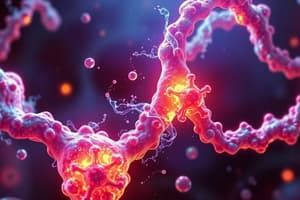Podcast
Questions and Answers
What is the term for the inactive form of an enzyme that requires activation?
What is the term for the inactive form of an enzyme that requires activation?
- Holoenzyme
- Apoenzyme
- Zymogen (correct)
- Cofactor
Which step comes first in the enzyme-catalyzed reaction according to the Michaelis-Menten equation?
Which step comes first in the enzyme-catalyzed reaction according to the Michaelis-Menten equation?
- Binding of substrate (correct)
- Conversion of bound substrate to product
- Release of product
- Formation of enzyme-substrate complex
What is the role of the active site in an enzyme?
What is the role of the active site in an enzyme?
- Storage of coenzymes
- Isolation of the enzyme from the substrate
- Determination of enzyme concentration
- Binding of substrates and catalytic activity (correct)
How are systematic names of enzymes typically constructed?
How are systematic names of enzymes typically constructed?
What does NAD primarily function as in liver alcohol dehydrogenase?
What does NAD primarily function as in liver alcohol dehydrogenase?
What are enzymes primarily made of?
What are enzymes primarily made of?
What does enzyme specificity refer to?
What does enzyme specificity refer to?
Which of the following enzymes exemplify absolute specificity?
Which of the following enzymes exemplify absolute specificity?
What is an active site in an enzyme?
What is an active site in an enzyme?
What are coenzymes primarily composed of?
What are coenzymes primarily composed of?
Which statement correctly describes a holoenzyme?
Which statement correctly describes a holoenzyme?
What type of enzyme specificity involves attacking a group of similar compounds?
What type of enzyme specificity involves attacking a group of similar compounds?
What is a prosthetic group in the context of enzymes?
What is a prosthetic group in the context of enzymes?
Flashcards
Zymogen
Zymogen
An inactive precursor of an enzyme. It is activated by a specific process, usually involving cleavage of a peptide bond.
Active Site
Active Site
A specific three-dimensional region on an enzyme where the substrate binds and undergoes a chemical reaction.
Apoenzyme
Apoenzyme
The protein component of an enzyme, lacking the non-protein cofactor.
Cofactor
Cofactor
Signup and view all the flashcards
Holoenzyme
Holoenzyme
Signup and view all the flashcards
Enzyme Definition
Enzyme Definition
Signup and view all the flashcards
Enzyme Efficiency
Enzyme Efficiency
Signup and view all the flashcards
Enzyme Specificity: Substrate Specificity
Enzyme Specificity: Substrate Specificity
Signup and view all the flashcards
Enzyme Specificity: Group Specificity
Enzyme Specificity: Group Specificity
Signup and view all the flashcards
Enzyme Specificity: Reaction Specificity
Enzyme Specificity: Reaction Specificity
Signup and view all the flashcards
Study Notes
Enzymes-1
- Enzymes are proteins that act as catalysts, increasing the rate of chemical reactions. A literal definition relates them to yeast.
- Enzymes are proteins, and some are ribonucleic acids.
- Enzymes are highly efficient, producing 103 to 108 products per second and operating at 37°C. They are not consumed or changed during a chemical reaction.
- Enzymes exhibit specificity.
- Substrate specificity: enzymes only attach to one particular substrate (e.g., urease for urea). If the substrate is an isomer (D or L), the enzyme only works on one isomer.
- Group specificity: enzymes target groups of similar compounds (e.g., L-amino acid oxidase only attacks L-amino acids, not D-amino acids).
- Low/relative specificity: enzymes bind to specific types of bonds (e.g. peptidase binds to peptide bonds in different peptide proteins).
- Reaction specificity: enzymes catalyze specific pathways (e.g., glucose oxidase only catalyzes gluconic acid synthesis, not sorbitol synthesis).
- Most enzyme names end in "-ase".
- Active site (often a cleft): the substrate binding site of an enzyme.
- Substrate: the molecule on which an enzyme acts (e.g., starch for amylase, lipids for lipase).
- Holoenzyme (active enzyme) = Apoenzyme (protein part of the enzyme) + Coenzyme or cofactor (non-protein part of the enzyme).
- Not all enzymes require coenzymes. Coenzymes are complex, non-protein organic molecules that function as group transfer reagents and are categorized into two groups.
- Prosthetic group: a cofactor that binds strongly to an apoenzyme (e.g., heme in hemoglobin).
- Cofactors: cofactors weakly bind and easily dissociate from apenzymes (e.g., NAD in liver alcohol dehydrogenase).
- Not all enzymes are synthesized in their active form; some are synthesized as zymogens (e.g., pepsinogen, trypsinogen, and chymotrypsinogen).
- Most polar amino acids participate in catalysis within one or more enzymes.
- Enzyme-catalyzed reaction have three steps (Michaelis-Menten equation):
- Binding of substrate: E + S <=> ES
- Conversion of substrate to product: ES <=> EP
- Release of product : EP → E + P
- S = substrate; E= enzyme; ES= enzyme-substrate complex; P = product
- k1, k-1, and k2 are rate constants.
- The graph of substrate over time shows a decrease in substrate concentration with corresponding increase in product.
- Active enzyme = protein part + non-protein part
- Holo enzyme = (apoenzyme) + (cofactor)
- Protein part features an active site (like a pocket or cleft).
- Role of active site: substrate binding, determining enzyme specificity, and participating catalytically.
- E + S <=> ES <=> EP <=> E + P
Enzyme Nomenclature
- Trivial names: common names (e.g., pepsin, trypsin).
- Systematic names: include substrate name and "ase" (e.g., lipase, amylase, protease). This can also include type of reaction (e.g., lactate dehydrogenase).
Studying That Suits You
Use AI to generate personalized quizzes and flashcards to suit your learning preferences.




